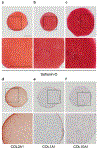Chondrogenic Differentiation of Human-Induced Pluripotent Stem Cells
- PMID: 36355287
- PMCID: PMC9830630
- DOI: 10.1007/978-1-0716-2839-3_8
Chondrogenic Differentiation of Human-Induced Pluripotent Stem Cells
Abstract
The generation of large quantities of genetically defined human chondrocytes remains a critical step for the development of tissue engineering strategies for cartilage regeneration and high-throughput drug screening. This protocol describes chondrogenic differentiation of human-induced pluripotent stem cells (hiPSCs), which can undergo genetic modification and the capacity for extensive cell expansion. The hiPSCs are differentiated in a stepwise manner in monolayer through the mesodermal lineage for 12 days using defined growth factors and small molecules. This is followed by 28 days of chondrogenic differentiation in a 3D pellet culture system using transforming growth factor beta 3 and specific compounds to inhibit off-target differentiation. The 6-week protocol results in hiPSC-derived cartilaginous tissue that can be characterized by histology, immunohistochemistry, and gene expression or enzymatically digested to isolate chondrocyte-like cells. Investigators can use this protocol for experiments including genetic engineering, in vitro disease modeling, or tissue engineering.
Keywords: Chondrogenesis; Human iPSCs; Stem cells; Tissue-engineered cartilage.
© 2023. The Author(s), under exclusive license to Springer Science+Business Media, LLC, part of Springer Nature.
Conflict of interest statement
Figures




References
-
- Mansour JM (2003) Biomechanics of Cartilage. In: Kinesiology: the mechanics and pathomechanics of human movement, vol 2e, pp 66–75
-
- Xia Y, Momot KI, Chen Z et al. (2017) Chapter 1 Introduction to Cartilage. In: Biophysics and biochemistry of Cartilage by NMR and MRI. The Royal Society of Chemistry, pp 1–43. 10.1039/9781782623663-00001 - DOI
Publication types
MeSH terms
Grants and funding
LinkOut - more resources
Full Text Sources

